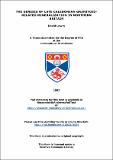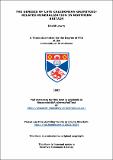Files in this item
The genesis of Late Caledonian granitoid-related mineralization in northern Britain
Item metadata
| dc.contributor.advisor | Stephens, W. E. | |
| dc.contributor.author | Lowry, David | |
| dc.coverage.spatial | 705 | en_US |
| dc.date.accessioned | 2013-07-08T15:45:28Z | |
| dc.date.available | 2013-07-08T15:45:28Z | |
| dc.date.issued | 1992 | |
| dc.identifier | uk.bl.ethos.303415 | |
| dc.identifier.uri | https://hdl.handle.net/10023/3834 | |
| dc.description.abstract | The main aim of this study was to develop a model for the sources of sulphur in Late Caledonian granitoids of Northern Britain in relation to their tectonic framework, and to constrain the sources of sulphur, fluids and metals in related mineralization. Using an approach of combined stable isotopic (S, C, H and O), fluid inclusion, geochemical (XRF) and mineralogical (electron probe, XRD, microscopy) techniques, it has been possible to estimate temperatures and conditions of formation. A further aim was to group the mineralization "styles" and to develop a model for each with implications for the sources of their host granitoids. The relative importance of magmatic processes and terrane characteristics in the formation of ore deposits of Northern Britain has been evaluated. The study of 23 mineralized granitoids amongst four terranes has yielded a range of δ³⁴S values between -21‰ and +24‰, and values for host rock lithologies between -22‰ and +29‰. Porphyry-style mineralization has δ³⁴S H₂S values restricted to the range -2‰ to +2‰. Fluid inclusions in porphyry related mineralization homogenize at temperatures up to 580°C with salinities of 5-60 eq.wt.% NaCl, and CO₂ is rare. Fluid inclusions, sulphur isotope geothermometry and mineral stabilities suggest that late veins hosted by plutonic rocks formed below 450°C, contained salinities of <15 eq.wt.% NaCl, and that CO2 was often an important primary component. External fluids commonly entered the magmatic systems at temperatures below 200°C in both porphyry systems and deeper veins. Parageneses of the porphyry-style mineralization generally contains early pyritohedra, followed by quartz, chalcopyrite, tetrahedrite, bornite and carbonate. The plutonic-hosted veins contain a more complex mineralogy, commonly including galena and sphalerite, and accompanied by minerals new to Scotland including berryite, gladite, hammarite, joseite-B, krupkaite, matildite, pearcite and tetradymite. Calcite is commonly the only carbonate present in plutonic-hosted mineralization, and wallrock alteration is restricted to propylitic type, except for vein selvages. Porphyry systems show more intensive wallrock alteration of sericitic or phyllic type, dolomite is the primary carbonate and is followed by late calcite. A model for the Late Caledonian mineralization has been developed. The sulphur and metals involved in the formation of a granitoid-related mineral deposit are commonly derived from the same sources. In the Northern Highland Terrane the Lewisian craton was an important source, whereas most components in the Grampian Terrane were derived from the sub-crustal magmas. In the Southern Uplands and North of England Terranes, the Lower Palaeozoic sediments hosting the granitoids provided a major component of metals, sulphur and fluids, either at the level of intrusion or as a source for S-type magmas at depth. The 834S values of the granitoids and related mineral deposits in the paratectonic Caledonides reflect the signatures of the host sediments. It is concluded that only in the Grampian Terrane do the characteristics of mineralization predominantly represent magmatic processes. In the remaining terranes, a significant contribution of fluids, sulphur and metals, from the craton or upper crustal sediments, modified magmatic and fluid conditions which controlled subsequent mineralizing processes. As a consequence of the behaviour of sulphur isotopes in sediment formation and with variation of ƒO₂ and pH in the mineralizing fluids, the sulphur isotope technique provides a robust indicator of magma sources and major crustal discontinuities such as terrane boundaries. The technique developed in this study may find wider application. | en_US |
| dc.language.iso | en | en_US |
| dc.publisher | University of St Andrews | |
| dc.rights | Creative Commons Attribution-NonCommercial-NoDerivs 3.0 Unported | |
| dc.rights.uri | http://creativecommons.org/licenses/by-nc-nd/3.0/ | |
| dc.title | The genesis of Late Caledonian granitoid-related mineralization in northern Britain | en_US |
| dc.type | Thesis | en_US |
| dc.type.qualificationlevel | Doctoral | en_US |
| dc.type.qualificationname | PhD Doctor of Philosophy | en_US |
| dc.publisher.institution | The University of St Andrews | en_US |
This item appears in the following Collection(s)
Except where otherwise noted within the work, this item's licence for re-use is described as Creative Commons Attribution-NonCommercial-NoDerivs 3.0 Unported
Items in the St Andrews Research Repository are protected by copyright, with all rights reserved, unless otherwise indicated.



